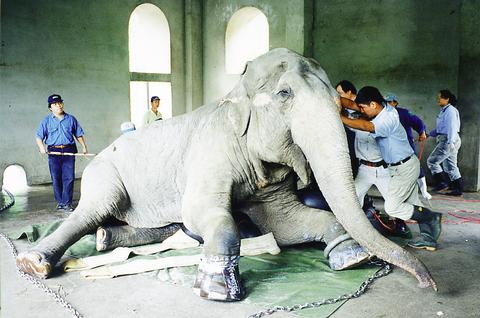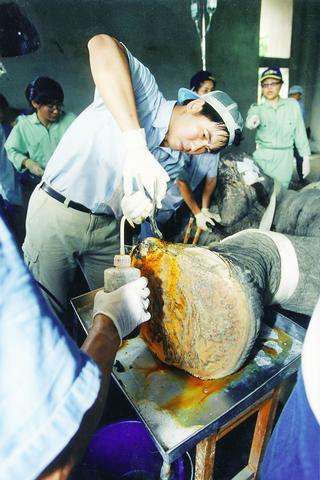Having a problem with your foot may not seem like a big deal ... unless you happen to be an elephant, that is, and a cantankerous one too. Malan (
How to treat Malan's infected foot had zoo veterinarians stumped. As soon as a wrap was put on the sore foot, Malan deftly shifted her three-and-a half tonnes and with a flick of her trunk, the bandage was history.
The answer finally came with a little creative thinking on the part of KS Shoes (

PHOTO: COURTESY OF TAIPEI CITY ZOO
They produced a shoe that may fit Malan and her vet is monitoring the developments.
A cranky patient
According to Tina Chen (

PHOTO: COURTESY OF TAIPEI CITY ZOO
"Malan has not had any training in obeying simple commands [as many younger elephants have]," Chen said. "Trained elephants can lift their leg on command to facilitate examination. We don't have that option with Malan."
To conduct an examination requires the application of a general anesthetic, something that zoo authorities did not undertake lightly. An operation to clean the wound was conducted in April, involving scores of medics and keepers.
"She is afraid of injections," Chen said, "and when Malan tries to avoid the needle, things can get pretty scary.

PHOTO: COURTESY OF TAIPEI CITY ZOO
"The rate of death and serious injury [among zookeepers around the world] is highest where they are working in an elephant enclosure," Chen said. "We have noticed that Malan will bully keepers if they are alone. We don't allow keepers to enter the enclosure alone anymore, for this reason," she added.
But with Malan's delicate medical condition, the risks of being in close contact with her can't be avoided.
As an elephant walks, its weight is transferred to base of its feet and the foot actually spreads with each step under the enormous weight.
The doctor watching over Malan is chief of the veterinary department of the Taipei City Zoo (
"It's like trying to heal a wound on a knee or elbow," Chin said. "You must reduce stress on the joint for it to heal."
According to Lin Hui-chen (
In the lead-up to the first full-scale inspection, Malan's wounded foot had been treated with medicine and bandages. "But within minutes of dressing the wound, she would tear the bandages off with her trunk, and would even dig out ointments," Lin said.
Chin said the idea of making a shoe for Malan began to take shape in early June. "It is the first time we've tried anything like this," he said. "We experimented with ways to make a mold of Malan's foot. Researchers tried various methods, even practicing on their own feet."
Treating Malan has been no simple matter. In addition to the danger that the keepers face from the temperamental elephant, Malan is also a danger to herself when drugged.
"We have to pull her down onto a bed of inner tubes so she doesn't hurt herself," Chen said. "The medical teams must work fast, because an elephant is not designed to lie down. There can be injury to internal organs because of their weight."
After the wound was first thoroughly cleaned of puss and putrescent flesh in April, a hole the size of a clenched fist remained.
Cinderella story
In July, Malan was again drugged so that a mold of her foot could be made. Ah-Shou (
Yang Shu-mei (
Made from thick PVC sheeting, synthetic leather, cowhide and fitted with non-slip panels in the sole, the boot is designed to allow observation of the foot, treatment of the wound, adequate drainage and ventilation, and above all, a very high degree of abrasion resistance. Woven steel cable takes the place of shoelaces.
"We make shoes for people with deformities and certain medical conditions," Yang said, "but this is the first time we have done anything like this."
After being approached by the zoo, KS offered its services free of charge "as a community service." Ah-Shou did the same. With this kind of support, Malan is likely to find a shoe that fits.
But for the moment, "We have to see how things go," Chin said. "The shoe is already wearing heavily."
"It has lasted over 10 days," Chen said. "That's pretty good." And Malan still has the extra shoe from Ah-Shou to try on if things take a turn for the worse.

In the March 9 edition of the Taipei Times a piece by Ninon Godefroy ran with the headine “The quiet, gentle rhythm of Taiwan.” It started with the line “Taiwan is a small, humble place. There is no Eiffel Tower, no pyramids — no singular attraction that draws the world’s attention.” I laughed out loud at that. This was out of no disrespect for the author or the piece, which made some interesting analogies and good points about how both Din Tai Fung’s and Taiwan Semiconductor Manufacturing Co’s (TSMC, 台積電) meticulous attention to detail and quality are not quite up to

April 21 to April 27 Hsieh Er’s (謝娥) political fortunes were rising fast after she got out of jail and joined the Chinese Nationalist Party (KMT) in December 1945. Not only did she hold key positions in various committees, she was elected the only woman on the Taipei City Council and headed to Nanjing in 1946 as the sole Taiwanese female representative to the National Constituent Assembly. With the support of first lady Soong May-ling (宋美齡), she started the Taipei Women’s Association and Taiwan Provincial Women’s Association, where she

Chinese Nationalist Party (KMT) Chairman Eric Chu (朱立倫) hatched a bold plan to charge forward and seize the initiative when he held a protest in front of the Taipei City Prosecutors’ Office. Though risky, because illegal, its success would help tackle at least six problems facing both himself and the KMT. What he did not see coming was Taipei Mayor Chiang Wan-an (將萬安) tripping him up out of the gate. In spite of Chu being the most consequential and successful KMT chairman since the early 2010s — arguably saving the party from financial ruin and restoring its electoral viability —

It is one of the more remarkable facts of Taiwan history that it was never occupied or claimed by any of the numerous kingdoms of southern China — Han or otherwise — that lay just across the water from it. None of their brilliant ministers ever discovered that Taiwan was a “core interest” of the state whose annexation was “inevitable.” As Paul Kua notes in an excellent monograph laying out how the Portuguese gave Taiwan the name “Formosa,” the first Europeans to express an interest in occupying Taiwan were the Spanish. Tonio Andrade in his seminal work, How Taiwan Became Chinese,